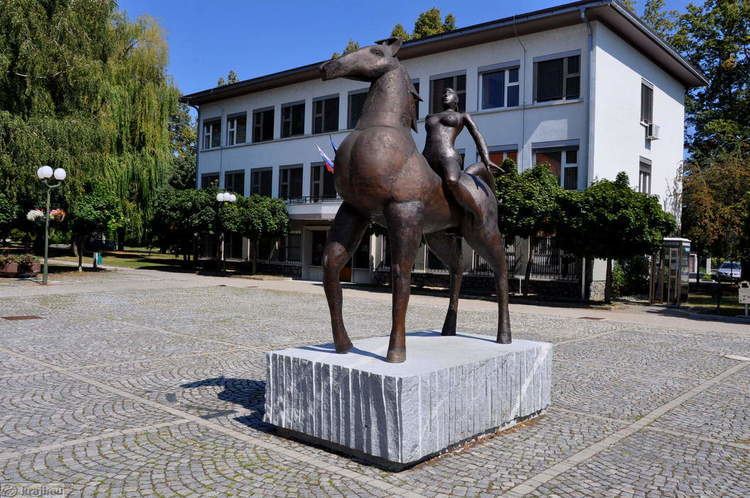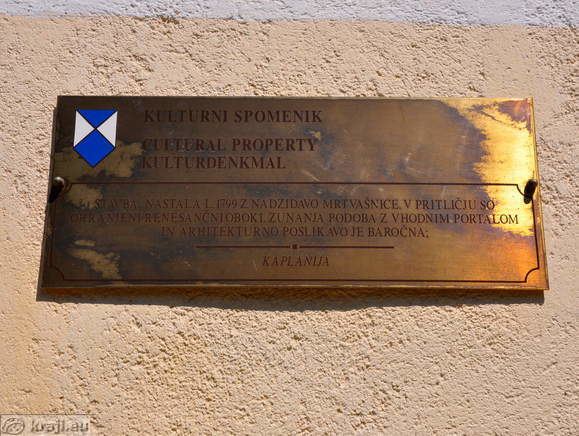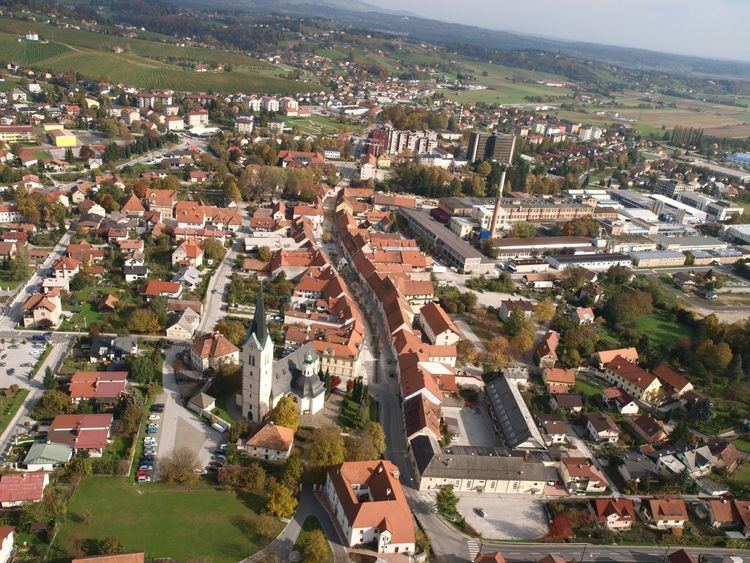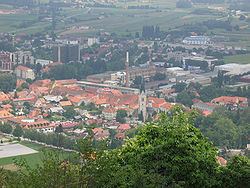Country Mayor Miran Gorinsek | Area 97.8 km2 | |
 | ||
Map of Slovenske Konjice
Slovenske Konjice ([slɔˈʋéːnskɛ kɔˈnjìːt͡sɛ] [- kɔˈnjíːt͡sɛ]; German: Gonobitz) is a town and a municipality in northeastern Slovenia. The area was part of the traditional region of Styria.
Contents
- Map of Slovenske Konjice
- Downhill trije krizi slovenske konjice
- Slovenske konjice
- Municipality of Slovenske Konjice
- History town sights
- Name
- Owners of the castle
- Tourism
- Culture
- Sport
- Prominent persons
- Twin towns sister cities
- International projects
- References

Downhill trije krizi slovenske konjice
Slovenske konjice
Municipality of Slovenske Konjice

The municipality is now included in the Savinja Statistical Region. It is the administrative and cultural centre of the Dravinja Valley. The municipality borders on the municipalities of Šmarje pri Jelšah and Šentjur to the south, Vojnik to the west, Zreče to the northwest, Oplotnica to the north, Slovenska Bistrica to the east, and Rogaška Slatina to the southeast. It spreads over 97.8 square kilometres (37.8 sq mi) and has a population of 13,600. About 100 km (62 miles) from Ljubljana, Graz, or Zagreb, it is easily reachable by the A1 motorway and via the small airport near Loče.
History & town sights

The town of Slovenske Konjice lies under the northern slopes of Mount Konjice (Slovene: Konjiška Gora) and the winegrowing Škalce Hills. On a hill above the town to the southwest are the ruins of 12th-century Gonobitz Castle (Slovene: Grad Konjice), which has later additions and was abandoned in the 18th century. Its ruins have been partially restored.
Immediately above Old Square (Slovene: Stari trg) stands the medieval Trebnik Mansion. The 850-year-old dense town line is a sloping square, from Trebnik Manor past St. George's parish church, along a small stream in an open channel, down to the Dravinja River. The new Town Square (Mestni trg) is on the other bank of the river, connected with Old Square by a bridge with four horse heads on the corners.
The dominant structure in the upper part of the town's medieval core is the archparish church dedicated to Saint George and belonging to the Roman Catholic Archdiocese of Maribor, dating back to the late 13th century with 18th-century additions (a Baroque side chapel). The veneration of the saint at this place goes even further back in history. The town was mentioned in written sources dating to 1165 as a seminal parish. The castle was first mentioned in 1148 and the market town in 1236. The town itself was not surrounded by walls. At the time of the Ottoman raids, the church with its vicarage served as a fortified refuge. A second church in the settlement is dedicated to Saint Anne. It dates to the mid-16th century with a 17th-century belfry and Baroque additions.
The main street and the transversal connections above the Dravinja are lined with longitudinal or transversally positioned one-storey houses with well-preserved Gothic cores and Renaissance additions. The façades were restyled in the 19th century (Biedermeier, Historicism). A rarity is the Art Nouveau building of the former savings bank. A Marian column dating to the mid-18th century and a column shrine dedicated to Saint Florian above the stream (both designed by the local artist Franc Zamlik in 1750) dominate the open square. The town core is well preserved.
Konjice played a role during the Slovenian peasant revolt of 1515, with rebels here composing a letter with their demands to send to the emperor in Vienna. Economic development was boosted after construction of main Vienna to Trieste road in the 18th century. During the 19th century the town got a local court. The Austrian Southern Railway was built in 1846, but it ran 15 km (9 mi) east of Konjice. On 20 June 1892 works started on a narrow gauge (760 mm) steam railroad line called Konjičanka from Poljčane to Slovenske Konjice, which was opened on 20 December 1892. On 29 June 1921 it was extended to Zreče. It was closed in 1963, and the tracks were removed in 1970. A Museum locomotive K.3 (Gonobitz), build by Krauss factory at Linz, used on this line, is on display at the Slovenian Railway Museum in Ljubljana.
Name
Over the centuries, the name Konjice appears in written documents in various forms: Gonviz (1251), Gombicz (1370), Gannabitz (1570), Gonaviz (1594), Gonavitz (1630), Gonwitz (1636), Gonowitz (1662), Ganowiz (1680), Gonnawitz (1680), and modern German Gonobitz. The adjective Slovenske was added to the Slovene name Konjice in 1934, under the Kingdom of Yugoslavia, in order to distinguish it from the town of Konjic in Bosnia and Herzegovina.
Owners of the castle
Tourism
Wine growing hills Škalce and Konjiška gora areas have many trails where local people like to walk.
The town has been rewarded for its efforts with the national "Most Beautiful Excursion Destination" award by Tourist Association of Slovenia for many years in a row.
The town of Slovenske Konjice hosts an international festival of underwater film and photography named "Sprehodi pod morjem" (Walking beneath the Sea), which is held every year at the end of January (on the last Thursday of the month).
Culture
Sport
Prominent persons
Prominent persons from the municipality of Slovenske Konjice include:
Twin towns – sister cities
Slovenske Konjice is twinned with:
